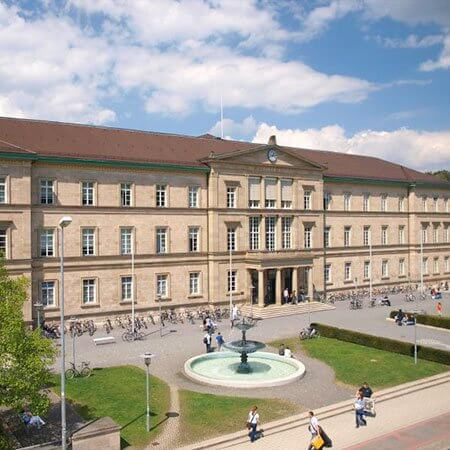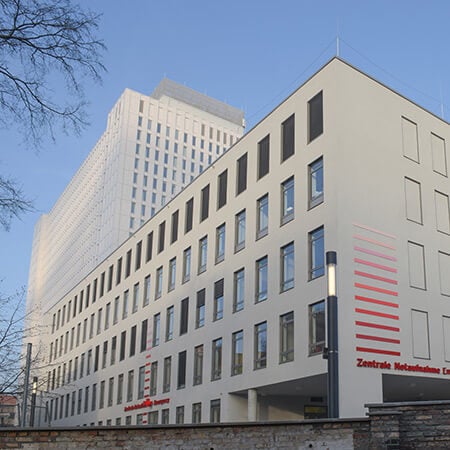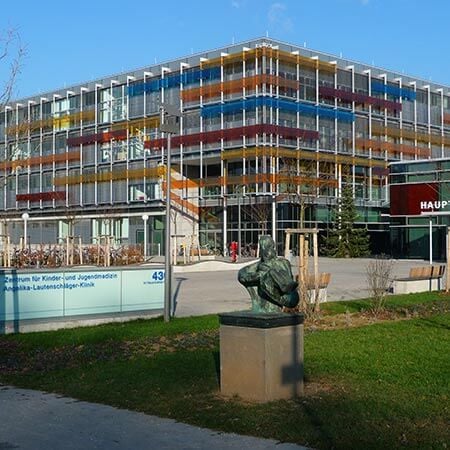Female Infertility — Diagnostic Laparoscopy: treatment in the Best Hospitals in the World
Treatment prices are regulated by national law of the corresponding countries, but can also include additional hospital coefficients. In order to receive the individual cost calculation, please send us the request and medical records.

Department of Adult and Pediatric Gynecology, Mammology, Obstetrics
According to the Focus magazine, the Department of Adult and Pediatric Gynecology, Mammology, Obstetrics is included in the ranking of the top German departments specializing in obstetrics and breast cancer treatment! The department offers the full range of diagnostics and treatment of diseases of the female reproductive system, breast pathologies. Also, the specialists of the department provide a comprehensive management of pregnancy, childbirth and postpartum care for both mother and child. Key attention is paid to the treatment of female genital cancers, as well as breast cancer treatment. For this purpose, the department has all the modern therapeutic techniques, as well as its our own innovative developments by the department doctors.







Department of Adult and Pediatric Gynecology, Mammology
According to the Focus magazine, the Department of Adult and Pediatric Gynecology, Mammology is one of the best medical facilities in Germany in its areas of specialization! The department offers a full range of preventive, diagnostic, and therapeutic services for women with diseases of the reproductive system and the mammary gland. The main focus is on the treatment of oncological diseases of the female genital organs and the mammary gland within specialized centers certified by the German Cancer Society (DKG). The department has accumulated significant clinical experience in the treatment of endometriosis, uterine fibroids, cervical dysplasia, urinary incontinence, and pelvic organ prolapse. The facility is developing the direction of pediatric gynecology with an emphasis on the surgical correction of congenital defects, treatment of infectious diseases (vulvitis, vulvovaginitis, and vaginitis), vaginal bleeding, labial adhesions, and ovarian cysts and tumors. A highly professional team of gynecologists and breast specialists with many years of experience takes care of women's health. The doctors pay special attention to comprehensive diagnostics, on the basis of which they create an individual treatment plan for each patient. The specialists are proud of the excellent results of their work, achieved thanks to their professionalism and state-of-the-art technical equipment.







Department of Adult and Pediatric Gynecological Endocrinology, Reproductive Medicine
The Department of Adult and Pediatric Gynecological Endocrinology, Reproductive Medicine offers the full range of modern methods of treating hormonal disorders in women and girls, as well as fertility therapy. The department is one of the few in Germany that specializes in all types of artificial insemination. Important attention is paid to the treatment of endometriosis, which often leads to infertility, uterine fibroids. Also, the scope of tasks of the department’s specialists includes endoscopic procedures aimed at fertility treatment. The treatment concept is developed individually for each patient, taking into account the specific clinical indications.






Laparoscopy is a surgical procedure, which allows the doctor to examine the abdominal cavity from the inside. It can be therapeutic or diagnostic. The diagnostic laparoscopy is often used in infertility. It allows the doctor to find out its reasons. Sometimes diagnostic laparoscopy is transformed into the therapeutic one, because if the doctor detects the factors of impaired fertility, he can immediately eliminate them.
What is diagnostic laparoscopy?
Laparoscopy is a minimally invasive procedure, which involves the insertion of a laparoscope and surgical instruments into the abdominal cavity. This is done through small incisions on the anterior abdominal wall.
The laparoscope is equipped with a video camera. It transmits the image to the monitor. As a result, the doctor has the opportunity to see the pelvic cavity from the inside. He is able to assess the condition of the fallopian tubes, detect foci of endometriosis or uterine fibroids, pelvic adhesions and other problems, which lead to decreased fertility and prevent pregnancy.
Laparoscopic surgery is increasingly used in developed countries. Open surgery in gynecology is used very rarely. The advantages of laparoscopic surgery are obvious. These include minor injury rate, low risk of complications, good aesthetic effect. There is no prolonged recovery, large scars on the body after this procedure. The postoperative period is not dangerous and is well tolerated by a woman.
When is the diagnostic laparoscopy in infertility required?
Infertility may have a wide variety of causes. One of the factors of impaired fertility is the tubal-peritoneal one.
The pelvic cavity of a woman includes the uterus with appendages. The appendages are the fallopian tubes and ovaries. The egg should enter the uterus from the ovary, but for this purpose it should pass through the tube. If it is obstructed, the pregnancy will not occur.
The impaired reproductive function of tubal or peritoneal origin can be determined even without laparoscopy. For this purpose, the doctors carryout hysterosalpingography. This is an X-ray examination involving the retrograde injection of contrast medium into the uterus and tubes. In case of detected impairments, their causes are not always clear. They can be clarified using laparoscopy. Should they be detected, the doctor will immediately eliminate most of the causes.
A woman may have the following problems with fallopian tubes:
- formation of multiple adhesions in the pelvic cavity;
- tubal obstruction;
- impairment of their function, for example, as a result of the destruction of fimbriae (villi, which capture the egg);
- formation of endometrial foci.
The doctor can examine not only the tubes and peritoneum, but also assess the condition of the ovaries, detect uterine fibroids with its predominant location in the abdominal cavity.
Diagnostic and treatment laparoscopy
There is no practical sense to detect the problem during the operation, but not to eliminate it. Therefore, in most cases, diagnostic laparoscopy is immediately transformed into the therapeutic one. The doctor can perform many different manipulations using long, remote-controlled surgical instruments. He is able to perform the following manipulations:
- dissect adhesions, which violate the patency of the fallopian tubes;
- perform plastic reconstruction of the tube;
- remove ovarian formations;
- cauterise endometrial foci;
- remove uterine fibroids.
If possible, the doctor will eliminate all factors, which reduce fertility and prevent pregnancy. This is enough to restore reproductive function. After surgery and rehabilitation, many women can get pregnant naturally without drugs or assisted reproductive technologies.
Recovery after diagnostic laparoscopy
The reproductive function cannot restored immediately after surgery. The onset of pregnancy requires a certain period of rehabilitation. This time is necessary for the regeneration of damaged tissues during laparoscopy, for the restoration of menstrual cycle, tone and peristalsis of the fallopian tubes.
The patient should stay in the hospital for several days. The duration of the early recovery phase depends on the extent of the intervention performed. The modern hospitals abroad provide every woman with comprehensive care, well-performed anesthesia during the postoperative period. The doctors take measures to avoid complications and restore the function of the organs of the reproductive system faster.
The rehabilitation does not take much time. 30-40% of women get pregnant during the first three months after laparoscopy. In most cases, the operation can restore fertility, but if the reproductive function is still impaired, infertility can be treated using assisted reproductive technologies.
Diagnostic laparoscopy abroad
The diagnostic laparoscopy can be carried out abroad. The Booking Health company can help with this matter. We will organize your trip, make it more comfortable, inexpensive and effective. We provide the following benefits:
- Selection of the best hospital, which doctors specialize in laparoscopy in gynecological diseases and infertility.
- Reduced cost of the examination and follow-up treatment due to the lack of coefficients for foreign patients.
- Establishment of communication directly with your attending physician.
- Preparation of the medical program taking into account the results of previous examinations.
- Booking the diagnostic laparoscopy on the convenient date for you.
- Monitoring of all stages of the program.
- Control of invoices and return of unspent funds.
- Buying and forwarding of medicines.
- Communication with the hospital upon treatment completion.
- Organization of additional examinations.
The Booking Health company will provide top-class services. We will book a hotel for you, airline tickets, arrange a transfer from the airport to the hospital and back.

